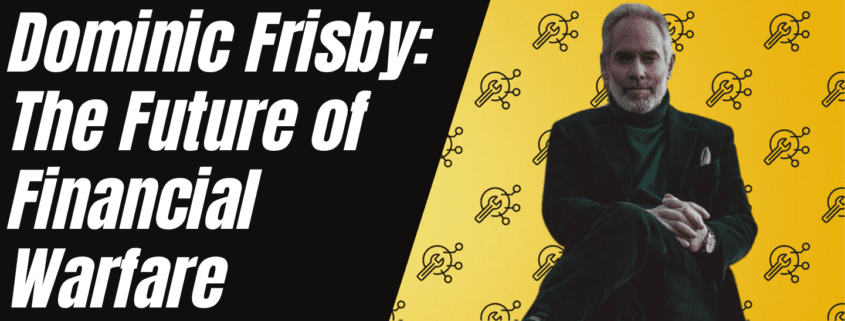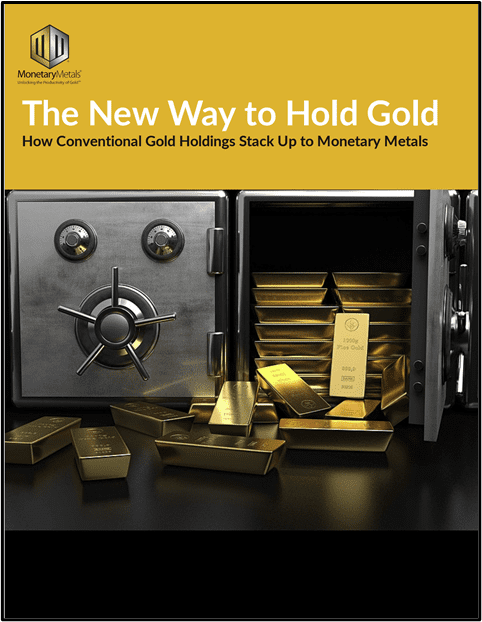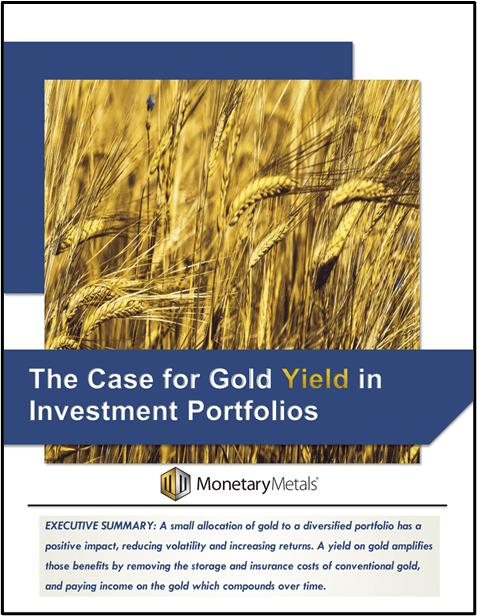Dominic Frisby: The Future of Financial Warfare
Dominic Frisby joins the podcast to discuss gold and bitcoin, the future of financial warfare, and if markets rally or wreck from here.
Additional Resources
Earn a yield on gold, paid in gold
The Case for Gold Yield in Investment Portfolios
Podcast Chapters
[00:00:00]: Dominic Frisby
[00:00:27]: Market Environment
[00:02:13]: Gold’s Potential
[00:03:52]: Central Bank Gold Buying
[00:05:18]: 3 Potential Futures
[00:08:04]: China’s Gold Holdings
[00:09:26]: Weaponization of Finance
[00:10:54]: Settling Trade in Gold
[00:12:22]: Bitcoin’s Potential
[00:14:52]: Final Question
Transcript:
Ben Nadelstein:
I’m joined by the funniest comedian on the planet, if I do say so myself, and the author of The Flying Frisbee, Dominic Frisby. Dominic, how are you doing today?
Dominic Frisby:
I’m doing very well, thank you. How’s it going?
Ben Nadelstein:
Doing great, Dominic. We are in one of the craziest market environments I’ve probably ever seen in my entire life. What do you make of it? Most people said 5% interest rates, the economy would be like a parking lot, just completely flattened. Yet here we are. Market’s doing okay, unemployment pretty low, inflation trending downwards. Things seem all right.
Dominic Frisby:
Yeah. At the moment, there’s a bit of a lag with interest rates. You don’t really know how much damages have been done until about six or nine months later, but it seems to be surviving. In the UK, I think real estate is starting to look really dodgy. Us real estate seems to be quite location-specific. I follow the market in Palm Springs in California quite closely because I have family who live there, and that seems to be surviving. But I guess people who move to Palm Springs are already quite capital-rich. They don’t have to borrow that much. But in areas where the margins, yeah, there are bigger margins, so real estate’s got problems. The bond market obviously has got problems. But yeah, it seems to be just about surviving. Everyone’s talking about the recession, but it seems to just stay in the positive. I have to say, gold is looking pretty good at the moment. It’s flirting with $2,000. It doesn’t… It went from 1,800 to 2,000 in about four or five days. That was a rocket of a move, and it was very overbored. You would have expected it to pull back, and it came back $50, but only momentarily, and now it’s back up there.
I think gold is looking good. There’s a trader called Peter Brand who’s a real veteran trader and he trades using patterns, pattern recognition, he calls it. And if bank balances are anything to go by, he’s a very, very clever man. And he described the gold chart, the monthly gold chart, which has displayed a bullish engulfing pattern, whatever that is. But he said it’s one of the most bullish charts he’s seen in his 48 years of investing and trading. A lot of people have been talking about this cup and handle. But once gold can get into new highs, then it’s all clear. I think it’s looking really good. We could see it as soon as next year because when it moves, it just goes on like a six-month tear away. I think gold could easily go to two and a half thousand, 2,700 by this time next year. I’m very bullish about gold. I’m quite cynical about gold at times, but at the moment, I think it looks pretty good.
Ben Nadelstein:
Well, I think the fact that the gold is staying so high in price despite headwinds, most people say gold has no income. Obviously, we pay income on monetary metals. But most people say, Hey, opportunity costs 5% on a treasury bill. I’d rather do that. Why would I buy a shiny pet rock? They think, Oh, stocks are doing really well. I can get into stocks. But surprisingly, gold has held up well. How much do you think of that has to do with central bank gold buying and the fact that we’re seeing more and more conflicts pop up as more and more debt is issued. Do you think most people are looking around and saying, Now is probably a good time to buy gold?
Dominic Frisby:
There’s no doubt that central banks are buying a lot of physical gold. And most of the central banks that are buying that physical gold are situated along the Silk Road. They’re part of the Shanghai Cooperation Organization. Basically, massive trading block in Asia, all the stands are buying loads of gold. China obviously as well. But I don’t think that sets the price. I think the price is set in the paper markets in the US, in North America mostly. I think the actual spot price in Shanghai is above the actual recognized spot price in the US. It’s higher, which is unusual. But yes, I think the price is set in the paper markets. There’s a concern for the US dollar, real rates are higher than actual rates, even so on. There’s a lot of divergences happening between gold and certain treasuries where normally they rise and fall together. I think the price is set in the paper markets and at the moment in the paper markets, there’s an appetite for gold. The reasons are obvious. I think there’s three potential futures for gold. It’s an analog asset in a digital age and all the value in the world at the moment is digital.
Whether it’s digital money, 99% of money is digital, the bomb market, the stock markets, everything’s digital. The digital economy grows at three times the rate of the physical economy. And in all of this, gold is the most analog asset there is in a digital world. And if you think you go into a shop and you buy something in the shop and you use your credit card and it talks to the credit card machine, it talks to the shop, everything’s just millions and millions of promises sent between parties that trust each other. And gold is the one asset in the world, maybe Bitcoin, that doesn’t involve trust. Its value is in itself. It’s a bearer asset. Excuse me, but there are three potential futures for gold. One, is it perhaps it is to finance as the horse was to transport. It’s irrelevant now that we’ve invented the motor car or whatever. But to keep coming back to this thing, one possibility is that gold just goes back to just being jewelry. I say goes back, but that’s not quite right. But it’s just jewelry. And it gradually reverts to that. It’s never going to go to nothing, but its value is something attractive.
The second possibility is that it’s the money of last resort, so its only role is jewelry and insurance. And then the third possibility is that it actually goes back to having some monetary function. Now, in my view, it’s never going to be a currency. It hasn’t been a currency for ages. We never really used gold as currency. We used silver and nickel and copper. But it could still be money. There’s other forms of money. It’s a medium of exchange, a store of value, and a unit of account, and a standard of deferred payment. But the reason I think gold, there’s a chance that it goes back to number three, is the extraordinary amounts of gold that China has accumulated. And China, I’ve done a lot of work on this, has accumulated… Chinese gold holdings, in my view, are maybe 10 times what they say they are. At the moment, America has 8,000 tons, China has 2,000 tons. I think China, if you look at Chinese gold imports, we don’t know total Chinese gold imports because what goes through Dubai, Switzerland, London is private. But we do know that a lot of gold that goes into China goes through the Shanghai Gold Exchange.
We know that 22,000 tons of gold have been withdrawn from the Shanghai Gold Exchange. Remember, China says it has 2,000, and we know that 22,000 has been taken out there, plus everything that is private. We also know that China has mined 7,000 tons of gold from geological records, and China is the world’s biggest gold miner, as well as being the world’s biggest gold importer. So 22,000 and 7,000, that brings us to 29,000 plus the 4,000 tons of gold that were already in China in the year 2,000, some privately held, some held by the central bank. That brings us to a total figure of at least 33,000 tons of gold. China doesn’t export any of the gold that it mines. It’s not allowed to. It has to keep it. We know that 33,000 tons of gold is in China. Let’s just say half of that is state-owned. It’s probably higher. But let’s just say half of that is state-owned, then you’re looking at 16, 17,000 tons of gold, state-owned gold in China. It says it’s got 2,000. Really, it’s got 17,000. America has 8,000. So China probably has twice as much gold as the US. Now, it’s not going to say we’ve got twice as much gold to the US because that would be a declaration of war.
But it has that card to play if it needs to at some stage. If it ever gets into a conflict to the US, the first thing that happens in conflict is the weaponisation of finance. It’s not known about this, but weaponisation of finance happened in World War II. The Nazis were shut out of the financial system. They resorted to using gold. But actually, for example, the Nazis printed loads of fake English currency and they were going to drop it in the UK, but they couldn’t because they didn’t have the air fleet to do it. This was 1943. So it never actually got dropped in the UK, but the money was used on the continent in Europe. Finance gets weaponised in war. And if China and the US ever get into any conflict, then you can be sure that China will weaponize its gold. And that is the point at which you will be very glad you have the gold that you have.
Ben Nadelstein:
And I do think there is a scenario where a country like Brazil, Russia, India, we’ve seen trade now between Russia and India. And Russia says we don’t want rubies because rubies are a useless currency. So I could see a possibility where instead of settling trade imbalances in a currency which nobody trusts or wants, that these countries say let’s settle in gold. That’s where these big players say, Hey, we’re going to start settling in gold. We’re not going to have it in the United States or stored in a Brings in Zurich. It’s going to be in a Shanghai gold exchange or in a Dubai, in a country where we feel more comfortable, where we’re not going to get locked out of.
Dominic Frisby:
Yeah, the problem with that is they’re looking at it. You know they’re looking at it because they’re the guys who are all buying it. But the problem is none of those countries trust each other. For a long time, the world has trusted the US dollar in the banking system. Every time a trade is effective, they’re not going to stick some gold on a plane and fly it over. The practicalities of who stores it, how much can they be trusted, that hasn’t been sorted yet. The way to fix that is for China to declare its gold holdings, andthen say that the Taiwan is freely redeemable with gold. And not everyone would necessarily redeem their want for gold. It’s just they need to demonstrate that it could be redeemable. And when people know that they could redeem it if they wanted to, that’s the point at which you win international trust. I think we’re a good few years away from that, but it’s a possibility in the future.
Ben Nadelstein:
Let’s talk about the other alternative currency here, which is a Bitcoin, which is a crypto of some sort, whether gold or others. How do you see that happening? Because we’ve had a lot of speculation, hey, Bitcoin is going to be the new medium of exchange, store of value currency. It’s changed the narrative a lot. There was this big depreciation from all-time highs. Do you think that the air has fallen out of the crypto bubble that the shine is off? Or do you think there’s still some applications here that we’re missing?
Dominic Frisby:
Oh, Bitcoin. The possibilities with Bitcoin are just extraordinary. And to me, the risk is not owning Bitcoin. Sorry, the risk is not owning Bitcoin. It’s not owning Bitcoin. Because the potential of the thing is so extraordinarily large. The US dollar as a currency is limited by national borders and limited by the banking system. It’s impossible for some dude in Africa. It’s even hard enough for me to get a US dollar account in the UK. It’s just hard, problematic. Anyone can just download an app on their phone and start trading in Bitcoin. So there’s just a scale and it’s borderless. There’s a scalability to Bitcoin that even from today’s prices is extraordinary. And it would solve the problems that the Shanghai cooperation organization is having. I don’t think they’ll start using Bitcoin, but there’s a possibility that they could. Heck, China mines enough of this stuff. So yeah, I think Bitcoin’s potential is just too big to ignore. I know Keith is not the biggest fan. He’s always slagging it off on Twitter and stuff, but he’s wrong.
Ben Nadelstein:
Love it. That’s why we like to have other voices on the show. Dominic, let’s finish here with two questions. First, what are some indicators that you’re looking at? Who are some voices that you’re listening to to stay abreast of the markets and say, Hey, when I listen to this person, I know what’s going on. Or when I look at this indicator, I can see something’s up.
Dominic Frisby:
I don’t know. I don’t listen to people anymore. I’ve stopped. I used to listen to Michael Saylor on Bitcoin because he’s just so extraordinarily articulate about it. But on gold, I like drukenmiller. When I listen to an interview with drukenmiller, I try not to listen to the permables because they’re permables and gold doesn’t only go up. Right. And I’m a big believer in moving averages. They tell a story, the short-term stories told by the short-term moving averages and the mid and long-term stories told by the long, where are they going? I listen to moving averages and gut.
Ben Nadelstein:
The Dominic Frisby gut, that’s who we should listen to. Okay, and then final question here. What’s a question we should be asking all future guests of the Gold Exchange Podcast?
Dominic Frisby:
Is gold to money as the horse was to transport?
Ben Nadelstein:
Dominic Frisby, I love it. Thank you so much for joining the Gold Exchange Podcast. Where can people find more of your work?
Dominic Frisby:
Theflyingfrisby.com or flyingfrisby.com, either of those will take you there. That’s my newsletter and there’s a free version and a paid version and you will get extraordinary insights, the like of which you will not read anywhere else.
Ben Nadelstein:
Dominic Frisby, thank you so much. We’d love to see you again.
Additional Resources for Earning Interest in Gold
If you’d like to learn more about how to earn interest on gold with Monetary Metals, check out the following resources:
In this paper, we look at how conventional gold holdings stack up to Monetary Metals Investments, which offer a Yield on Gold, Paid in Gold®. We compare retail coins, vault storage, the popular ETF – GLD, and mining stocks against Monetary Metals’ True Gold Leases.
The Case for Gold Yield in Investment Portfolios
Adding gold to a diversified portfolio of assets reduces volatility and increases returns. But how much and what about the ongoing costs? What changes when gold pays a yield? This paper answers those questions using data going back to 1972.










Leave a Reply
Want to join the discussion?Feel free to contribute!